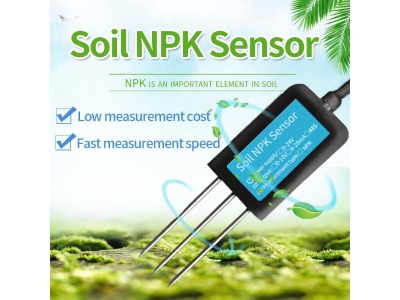Precision farming, also known as precision agriculture, is a modern approach to crop production that utilizes advanced technologies to optimize farm management practices. One crucial aspect of precision farming is the use of soil sensors, which provide real-time data and insights about soil conditions. By accurately monitoring soil moisture levels, nutrient content, and other important parameters, farmers can make informed decisions and implement targeted interventions to improve crop yields. In this article, we will explore the role of precision farming soil sensors in enhancing agricultural productivity, their benefits, and potential applications.

Chapter 1: Understanding Precision Farming Soil Sensors
Precision farming soil sensors are sophisticated devices designed to measure and monitor various soil properties. These sensors utilize advanced technologies such as capacitance, electrical conductivity, and spectral analysis to gather data on soil moisture, nutrient levels, pH, temperature, compaction, and salinity. The collected data is then transmitted wirelessly to a central control system, where it can be analyzed and interpreted for decision-making.
Chapter 2: Benefits of Precision Farming Soil Sensors
The use of precision farming soil sensors offers several key benefits to farmers and agricultural stakeholders:
a. Improved Water Management: Soil sensors provide accurate and real-time data on soil moisture levels. This information allows farmers to determine precisely when and how much irrigation is required, preventing overwatering or underwatering. Optimal water management reduces water consumption, minimizes runoff, and conserves this valuable resource.
b. Enhanced Nutrient Management: Soil sensors help farmers assess the nutrient content in the soil. By measuring important parameters such as nitrogen, phosphorus, and potassium levels, farmers can apply fertilizers more precisely and efficiently. This targeted approach minimizes nutrient waste, reduces environmental pollution, and ensures optimum plant nutrition.
c. Disease and Pest Management: Soil sensors can aid in the early detection of disease and pest infestations by monitoring soil conditions favorable to these threats. By detecting changes in soil moisture, temperature, and other relevant factors, farmers can take proactive measures to prevent or mitigate the impact of diseases and pests on their crops.
d. Yield Optimization: With precise and detailed information on soil properties, farmers can make data-driven decisions to optimize crop yields. By identifying areas with specific soil deficiencies or excesses, farmers can implement site-specific management practices such as variable rate seeding, fertilizing, and irrigation. This targeted approach ensures that crops receive optimal growing conditions throughout the field, leading to improved yields.
Chapter 3: Applications of Precision Farming Soil Sensors
Precision farming soil sensors find applications across various agricultural sectors and crop types. Some key applications include:
a. Row Crops: Soil sensors are particularly beneficial for row crops such as corn, soybeans, and wheat. By monitoring soil moisture levels, farmers can implement precision irrigation practices and prevent water stress. Additionally, nutrient monitoring helps optimize fertilizer application, ensuring that plants have access to the right nutrients at the right time.
b. Fruit Orchards and Vineyards: Soil sensors play a vital role in fruit orchards and vineyards, where precise irrigation management is crucial. By monitoring soil moisture levels at different depths, farmers can adjust irrigation schedules to meet the specific water needs of fruit trees and grapevines. This targeted approach improves water-use efficiency and enhances fruit quality.
c. Greenhouse Cultivation: Soil sensors are valuable tools in greenhouse cultivation, where maintaining optimal growing conditions is critical. By continuously monitoring soil moisture, temperature, and nutrient levels, farmers can create an ideal environment for plant growth. This leads to healthier plants, improved crop quality, and increased productivity.

d. Hydroponics and Vertical Farming: Soil sensors also find applications in soilless farming systems such as hydroponics and vertical farming. In these systems, sensors monitor nutrient solutions, pH levels, and other parameters to ensure optimal plant growth and nutrient uptake. This precise control over growing conditions maximizes crop yields and minimizes resource waste.
Chapter 4: Integration and Data Analysis
To fully capitalize on the potential of precision farming soil sensors, integration with other technologies and data analysis techniques is crucial. Integration with geographic information systems (GIS) allows farmers to map soil properties across their fields and identify areas that require specific management practices. Furthermore, incorporating machine learning algorithms and artificial
